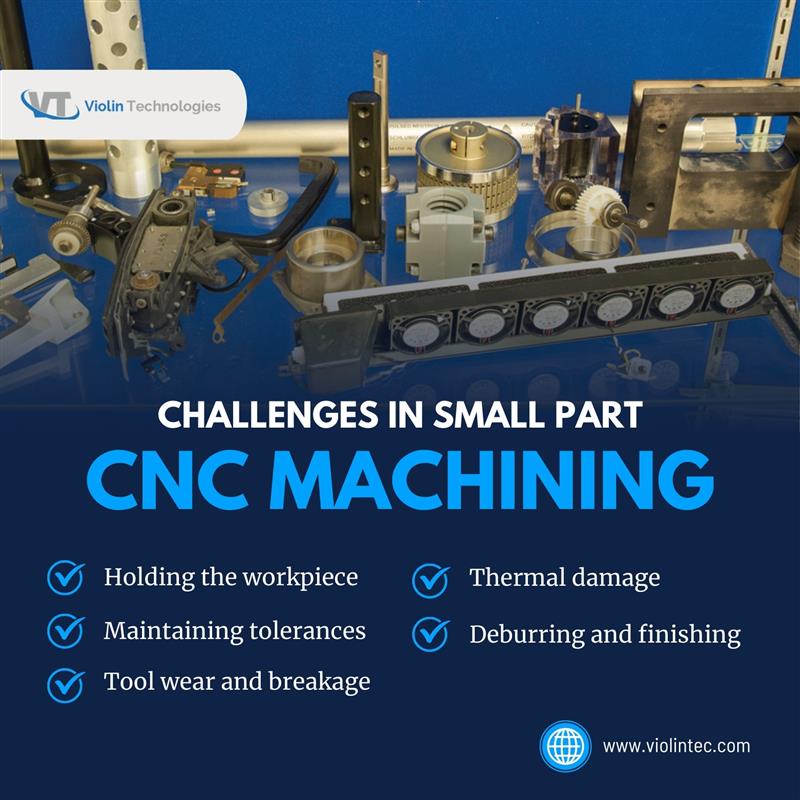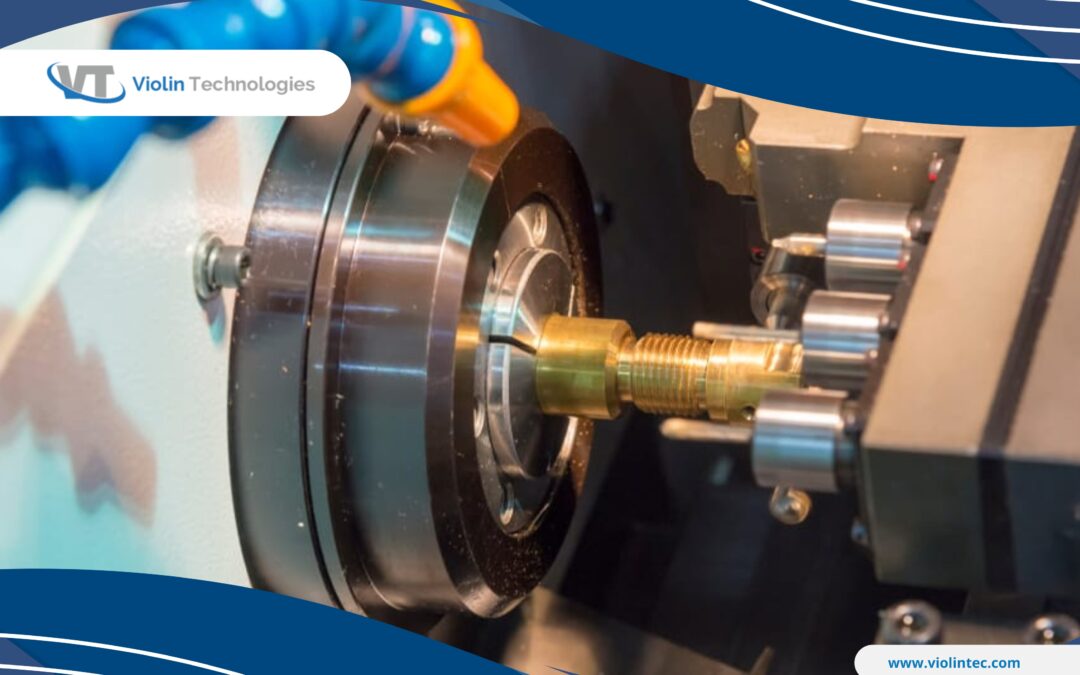Let’s examine the most prevalent challenges in small-part, large-part, and high-volume CNC machining, and how to overcome them.
Challenges in Small Parts CNC Machining
Small parts CNC machining has certain difficulties that may affect the production process’s effectiveness and caliber. Effectively addressing these problems calls for accuracy and innovation.
1. Holding the workpiece
Challenge: Holding tiny parts in place can be a challenge. There is a significant chance of losing or injuring the part, and standard clamps frequently don’t work.
Solution: To hold items firmly and reduce vibrations, use vacuum pallet systems and specific fixtures.
2. Maintaining Tolerances
Challenge: Achieving tight tolerances in small parts can be challenging, as even a small vibration or tool deflection might disrupt the entire procedure.
Solution: Fine-tooled, high-precision CNC machines and optimizing tool paths can improve detailed tolerance and accuracy.
Precision-machined components manufacturers in the USA specialize in delivering parts manufactured to exact specifications and tight tolerances, ensuring superior performance and reliability.
3. Tool Wear and Breakage
Challenge: Small parts need fine, delicate instruments that can break under strain or wear out quickly. It is essential to monitor the condition of the tool closely.
Solution: To increase tool life, use wear-resistant materials, monitor and replace tools often, and optimize cutting conditions.
4. Thermal Distortion
Challenge: The heat produced during machining makes small items more vulnerable to thermal distortion.
Solution: Use cooling strategies and modify operating settings to control heat efficiently.
5. Deburring and Finishing
Challenge: At a tiny size, it is far more difficult to remove burrs or achieve a smooth finish, frequently necessitating the use of specialized tools or manual labor.
Solution: To guarantee smooth surfaces without causing damage to tiny components, use ultrasonic finishing systems or precise micro-deburring equipment.

Challenges In Large Parts CNC Machining
There are several challenges associated with using CNC technology to machine large parts, which can increase production complexity and expense.
1. Logistics and Handling
Challenge: Handling and locating large pieces might be difficult due to their size and weight.
Solution: To safely move and secure massive pieces, use cranes and improve logistic planning.
2. Time and Machining Capacity
Challenge: Not all CNC machines can handle large workpieces. Sometimes specific setups or multi-step processes are required. Furthermore, the larger the pieces, the longer the machining time will take.
Solution: Optimize feed rates and cutting speeds to increase productivity without sacrificing quality.
3. Tool Reach and Accessibility
Challenge: Prolonged or specialized tools may be needed to reach all surfaces, particularly internal features, which raises the possibility of tool deflection or chatter.
Solution: Increase machining capabilities by using multi-axis CNC machines and long-reach tools.
4. Maintaining Tight Tolerances
Challenge: The whole surface of a larger part can be challenging for consistency and uniformity. Critical factors include machine calibration and heat expansion.
Solution: To guarantee uniformity, use cutting-edge measuring methods and calibrate machinery regularly.
5. Cost of Operation
Challenge: Higher operating costs as a result of longer machining times and more usage of materials.
Solution: Reduce total costs by optimizing material consumption and machining processes through strategic planning and execution.
Common Challenges in High-Volume CNC Machining
Although high-volume CNC machining provides significant productivity, it also presents several difficulties that may compromise effectiveness and result in quality. Effectively handling these difficulties is essential to preserving throughput and product quality.
1. Tool Wear
Challenge: Because of constant use, tools deteriorate quickly.
Solution: To increase lifespan and decrease replacements, employ a strict maintenance program and better, more robust tools.
2. Heat Management
Challenge: Overheating can cause harm to parts and machines.
Solution: Regular machine rest and improved cooling systems help keep machines from overheating.
3. Material Handling
Challenge: To manage materials effectively to prevent bottlenecks.
Solution: Automated material handling systems and accurate scheduling will maintain smooth production and save time.
4. Maintaining uniform quality
Challenge: When manufacturing in large quantities, maintaining quality known as quality consistency is a challenge.
Solution: Strict quality control procedures and real-time monitoring to promptly handle any product standard deviations.
5. Process optimization
Challenge: To maximize volume while maintaining quality.
Solution: Methods of continuous improvement and the use of cutting-edge software for process management and efficiency are beneficial.
Overcoming the Challenges
Although there are challenges associated with each form of CNC machining, the answers frequently involve a combination of technology, expertise, and smart process design.
Invest in proper tools: Automation for high-volume production, heavy-duty setups for large items, and high-precision equipment for small parts.
Skilled Operators: For setup, monitoring, and troubleshooting, skilled machinists are crucial, regardless of how sophisticated the machine is.
Advanced Software: Real-time monitoring tools, simulation, and CAD/CAM help anticipate and stop issues before they arise.
Strict Quality Control: Automated measurement, statistical process control, and in-process inspections maintain high standards.
Continuous Improvement: Manufacturers may stay ahead of the curve by routinely evaluating procedures, educating employees, and implementing new technologies.
The best contract manufacturers in India offer end-to-end solutions from design support and manufacturing to assembly and testing.
Conclusion
There is no one-size-fits-all approach to CNC machining. Every situation requires a different strategy and level of experience, whether you’re working on a manufacturing run in the thousands, a part the size of a fingernail, or a component larger than a car. No matter the task at hand, manufacturers may provide quality, efficiency, and creativity by comprehending the particular difficulties associated with small parts, large components, and high-volume CNC machining.
FAQs
1. Why is it harder to machine smaller parts than larger ones?
During machining, small parts are susceptible to deformation or damage and require a high degree of precision.
2. What challenges come up when big pieces are machined?
Large pieces demand larger machines, stable configurations, and careful heat management to prevent warping.
3. How is CNC machining impacted by increased production volume?
To prevent accumulated faults, consistent tool performance, effective cycle times, and strict quality control are necessary.
4. Is it possible for the same machine to effectively handle both large and small parts?
Usually not; various machine setups and configurations are optimized to tolerances and part sizes.

